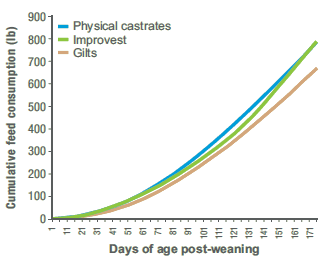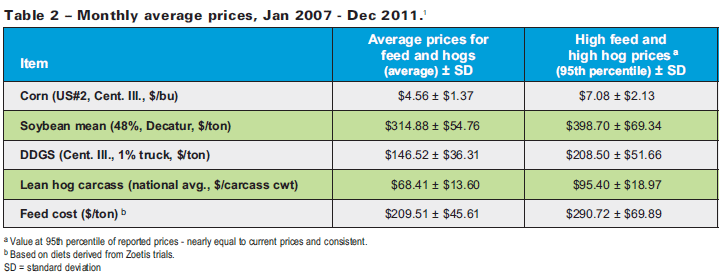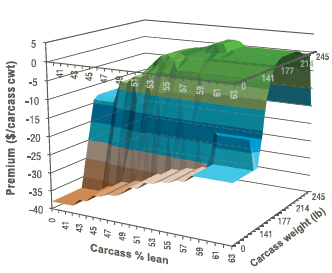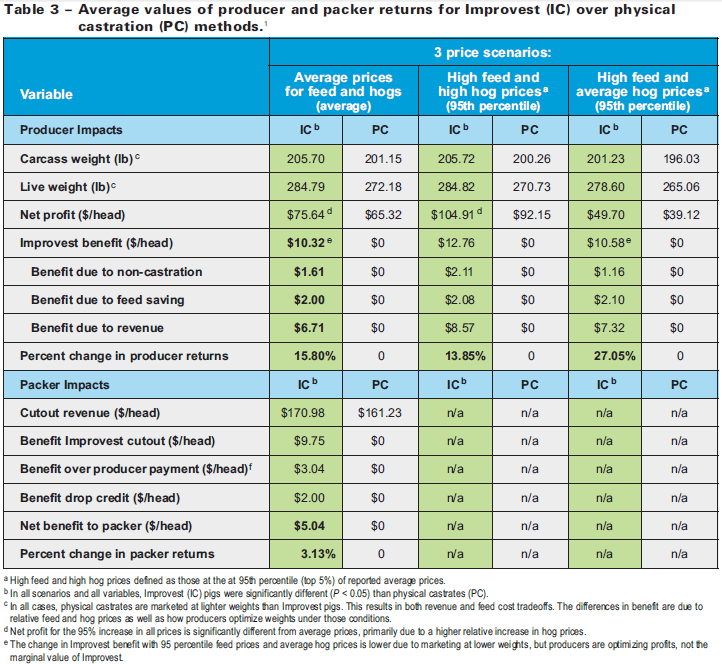



Comprehensive Economic Analysis of Improvest Adoption by the US Pork Industry
A panel of independent economists has assessed that producers who use Improvest can expect the optimal market weight of their animals to increase by an average of about 10 to 12 pounds per head on a liveweight basis (four to six pounds per carcass) compared with physically castrated males, according to Dr Brian Buhr (EconAnalytics LLC), Dr Glynn Tonsor (Agri-Food Analytics LLC), Dr Kelly Zering (North Carolina State University) and Dr Dennis DiPietre (KnowledgeVentures LLC) as well as Bobby Cowles, DVM, MS, MBA and Paulo J.U. de Moraes, DVM, MBA of Zoetis Inc.Key Points
A panel of economists estimated the impact of immunological castration (IC) verus physical castration (PC). They concluded that:
- IC barrows generate a potential increase of $5.32 per head in net income (after product plus administration costs of $5.00 per head)
- This value is comprised of benefits due to:
- cessation of physical castration (direct cost savings, fixed-costs dilution, increase in opportunity-profit from saved pigs)
- feed savings (heavier pigs with less feed) and
- increased revenue (heavier carcasses, higher average premium due to reduction in weight variation).
- The average optimal carcass weight for IC barrows is 10 to 12lb heavier on live-weight basis (4 to 6lb in carcass weight) over PC barrows when both are finished to their respective, different optimal carcass weight.
- For packers, the expected estimated net total return from IC barrows averages $5.04 per carcass.
- These benefits from Improvest are consistent in multiple marketing scenarios, even in challenging market situations when optimal carcass weights are reduced.
Improvest® (gonadotropin releasing factor analogue-diphtheria toxoid conjugate) is a FDA-approved veterinary prescription product developed by Zoetis that helps manage unpleasant aromas that can occur when pork from some male pigs is cooked. Improvest is a protein compound that works like an immunisation to temporarily protect against off-odours in pork. Its related global brand, Improvac® has been successfully used by pork producers in other countries for more than 10 years. FDA has determined that pork from pigs given Improvest is safe to eat and there are no residues that could affect human health. Regulatory authorities in more than 60 countries, including the European Union, Japan, South Korea, Russia and China, have reached the same conclusion.
Male pigs are given Improvest in the finish phase, eliminating the need for physical castration (PC). As a result, male swine are able to fully express their natural potential for feed-efficient growth, with all the inherent performance advantages of an intact male for the majority of the production cycle.
Improvest Program
Use of Improvest involves a two-dose regimen. The first dose should be administered after nine weeks of age to prime the immunological system of the male pig. The second dose is then administered at least four weeks after the first, between three and 10 weeks before harvest of the immunologically castrated (IC) barrows. This approach allows IC animals to express their naturally efficient growth potential, resulting in substantial feed savings per lb of gain compared to PC barrows. After the second dose, the male pig begins to eat substantially more feed per lb of gain and begins to increase the amount of fat in the carcass, thus attaining a desirable fat level for primal cut characteristics.
Optimal marketing strategies take these factors into account, timing the immunisations and harvest of the animals to maximise profits while maintaining targeted carcass cut-out characteristics.
Economics/Performance Overview
The impact of immunological castration with Improvest on the performance of male swine has been extensively researched. Table 1 summarises results of 12 US studies that compared the performance of contemporary IC barrows (Improvest) with that of PC barrows throughout the entire growing period.3 Improvest-managed barrows averaged 8.4 per cent improvement in feed/gain (F/G), 4.3 per cent greater average daily gain (ADG), and 0.047 inches (1.17mm) less backfat.

Based on research outcomes summarised in this Bulletin, producers adopting Improvest can increase net income by an average of $5.32 per IC barrow (net after cost of product and implementation). 1,2
The first obvious advantage of immunological castration with Improvest begins at the production facility, with adopting producers no longer needing to castrate male pigs. Elimination of physical castration can provide significant positive impacts on pre-weaning and post-weaning mortality and morbidity while also saving the value of the labour and inputs associated with this practice.
The authors estimate that the elimination of physical castration improves wean-to-finish net income by an average of $1.61 per male pig marketed, i.e. direct cost savings from non-castration, dilution of fixed costs and increased opportunity profit from saved pigs.
Of course, adoption of Improvest also brings some expenses. The full cost of utilising Improvest is estimated to be $5.00 per male pig, which covers the cost of the product as well as inputs needed for administration and documentation. Farm staff will need to separate male and female pigs, e.g. separate pens at the minimum, to facilitate the administration, documentation and certification of both Improvest doses.
Intact males and PC barrows demonstrate quite different patterns of feed consumption (Figures 1 and 2) and carcass lean accretion even though their growth rates are typically similar until the time of the second Improvest dose.
Male pigs that have not been castrated but have received the first dose of Improvest consume feed and grow like untreated intact male hogs. This means F/G is dramatically improved compared to PC males and gilts but growth rate is similar to PC barrows. Before administration of the second Improvest dose, the carcasses of Improvest-managed males are very lean compared to PC barrows. However, upon administration of the second dose, Improvest males increase feed consumption, decrease feed efficiency and begin generating more fat in the carcass.
This process implies an economic trade-off involving choice of the optimal harvest weight which produces the greatest profits while maintaining the necessary fat (especially in belly cuts) essential to pork quality and value.


Simulation Model of Profit Maximisation
Zoetis commissioned an independent panel of agricultural economists to explore management options for Improvest-adopting producers. The panel utilised a stochastic optimisation approach which established how the optimal harvest weight of an IC barrow is likely to compare to that of a PC barrow on a national basis. The analysis estimated net returns to both producers and packers in a stochastic model of hog and pork production. Base price variables used for the analysis (Table 2) were derived from averages of monthly data over five years (2007-2011).

Market Weights
An Improvest-managed male will typically reach profit optimisation with a carcass weight of five to six pounds heavier than a PC barrow, without increasing days in the finisher. Improvest males have lower carcass yields due to the presence of the scrotum, testicles and associated organs, as well as some other minor carcass changes. Thus, live weight at slaughter will likely be 10 to 12lb heavier than a PC barrow. These estimates assume adequate pen space is provided so ADG suppression does not occur at these heavier weights. Producers need to ensure stocking rates are appropriate.
Results of the economic analysis presented here are not intended to predict the optimal weight for any individual or marketing group of US producers selling to any single packer. Rather, they represent the expected national average difference between the likely profit-optimising weights of PC and Improvest-treated males under a variety of production systems, feed ingredient prices, and packer buying schemes.
A sensitivity analysis was conducted to estimate the optimal weights of IC versus PC barrows during periods when feed ingredient prices are high and pass-through of these costs to the hog price has not yet occurred. While the optimal weights of both types of animals are reduced under this scenario (as expected), the differential profit-optimisation weight between IC and PC barrows remains essentially the same. Whenever market conditions are forcing average sell-weights down, producers need to pay special attention to the timing of the second Improvest dose to ensure that appropriate fat is allowed to accumulate on lighter carcasses, thereby meeting consumer preferences and avoiding erosion of carcass values (discounts).
On average, Improvest-managed barrows are estimated to receive a $1.75 per cwt premium over PC barrows when both are finished to their respective (but different) optimal carcass weights. This is primarily because Improvest carcasses are expected to offer a smaller coefficient of variation, i.e. smaller standard deviation relative to their different optimal carcass weights.
This improvement in the average premium paid for Improvest-managed males can be interpreted as a signal of enhanced value from the retail/consumer sectors of the production chain, mediated through the packer buying scheme.
Carcass Value
Quality premiums paid by packers are based on carcass composition. Figure 3 summarises the premium and discount schedule used by a major US packer (representative of other packers) valued on a percent lean and weight basis.
In addition, Figures 4 and 5 break-out specific examples of premiums/discounts for 207-lb carcass weight and 55 per cent lean, to illustrate optimal premiums. In general, only narrow ranges of carcass weights and lean percentages yield the highest premiums.
The key point is that premiums fall sharply when pigs are heavier or lighter. Therefore, in addition to optimal weights of Improvest-managed and PC pigs being affected by productivity and feed-cost changes, the optimum market weight will also be affected by packer quality payments or discounts related to carcass composition averages and variances.



As mentioned earlier, Improvest-treated males produce a different carcass than PC males. Carcass cut-out data collected by Zoetis in a trial utilised for the optimal weight estimations was employed by the consulting economists to evaluate the expected value of an Improvest-managed carcass compared to a PC barrow carcass. Carcass component price distributions (including the drop) were collected from USDA sources and used to simulate the likely value distribution differences between the two types of carcasses.
Table 3 summarises average producer and packer returns for Improvest-managed pigs compared to PC pigs (three price scenarios). Using the average price scenario, the mean of total returns for the packer from an Improvestmanaged male was estimated to increase $9.75 compared to a PC barrow. After paying the producer $6.71 for the added weight and premium increase, a net improvement in returns of $3.04 was realized for the primal cuts. In addition, an increase in the drop of $2.00 over the PC barrow was expected, thus yielding a total improvement of $5.04 in net returns per Improvest carcass.

Aggregate Analysis
Once all of these estimates were complete, an aggregate economic analysis was generated that quantified the likely impact from all of the direct effects originating from Improvest adoption. The aggregate effects were measured across the entire pork chain, from production through processing, retail and the consumer, as well as any impacts on related markets for key meats which substitute for pork in the diet of US consumers (and by aggregation, the ‘rest of the world’).
The economic ripples emanating from the initial effects reach out much farther than the industry in which they originate, and they move over an extended period of time until their full effect is realised. Initial effects produce impacts in markets that lead to many rounds of adjustments, not only in the originating market but in related markets as they all seek their new equilibriums.
A baseline US adoption scenario was assumed to start with modest Improvest adoption rates which then accelerate to a final market adoption rate over a 10-year period (Improvest adoption in four per cent, 17 per cent, 34 per cent, 50 per cent, 58 per cent and 63 per cent of male slaughter hogs in years 1 to 6, respectively, followed by consistent 65 per cent Improvest use for years 7 to 10). From this baseline, several other sensitivity analyses were conducted assuming:
- at the far-end of the spectrum, no adoption and a 15 per cent loss in market share due to global competition from adopters in ‘rest of the world’;
- an accelerated adoption profile which quickly moves from 0 per cent adoption to 90 per cent adoption by year 5 and which remains at that level for the duration of the 10-year analysis.
In general, the baseline scenario increases the net present-value of total meat consumer surplus by $1,802 million, with small losses to the beef and poultry sectors; and the net present-value of total societal surplus is expected to increase $3,663 million.
It is interesting to note that every part of the pork chain benefits from the adoption of Improvest, and every segment (hog producer, packers and retail) are significantly worse-off in a US ‘no adoption’ scenario. In other words, global adoption of Improvest in the absence of US adoption will substantially reduce the ability of US pork producers to compete for global market share.
Important Safety Information: Pregnant women should not administer IMPROVEST. Women of child-bearing age, as well as men, should exercise extreme caution when administering this product. Exercise special care to prevent accidental self-injection because of negative effects on reproductive physiology in both men and women. However, there is no risk associated with consuming pork from animals administered this product. IMPROVEST should not be used in female pigs, barrows or male pigs intended for breeding.
Conclusions
Based on their model assumptions, the panel of independent economists determined that producers who adopt Improvest can expect the optimal market weight of their animals to increase by an average of about 10 to 12lb per head on a liveweight basis (4-6lb per carcass) compared with PC barrows.
This outcome is consistent under a variety of cost and price scenarios.
Furthermore, Improvest-managed males will attain this added weight without any additional days on feed, and the carcass will command a slightly improved premium value primarily due to increased uniformity.
The expected improvement in net returns for US producers adopting Improvest (including costs and returns associated with increased production due to decreased pre-weaning mortality once castration stops) is $5.32 per head after accounting for $5.00 per head costs of Improvest use. This profit improvement for male pigs is derived as follows:
$2.00/head feed savings at new optimal weight
$6.71/head for higher optimal weight and carcass premium
$1.61/head more wean-to-finish net income (direct cost savings and decreased mortality because the practice of castration ceased)
= $10.32/head total of gross benefits
-$5.00/head net cost of Improvest programme, and
$5.32/head more net profit per male pig marketed.
References
1. Buhr B.L., Zering K. and DiPietre D. 2013. A comprehensive, full chain and US meat sector economic analysis of the adoption of Improvest® by the US pork industry. Am. Assoc. Swine Vet. 2013:189-194.
2. Zoetis Inc. A comprehensive economic analysis of the adoption of an immunological alternative to physical castration by the US pork industry. Internal whitepaper, 2013.
3. Cowles B., Meeuwse D. and Bradford J. 2013. Data summary of immunological castration impact in grow-finish performance of male pigs in USA. Am. Assoc. Swine Vet. 2013:375-376.
July 2013









